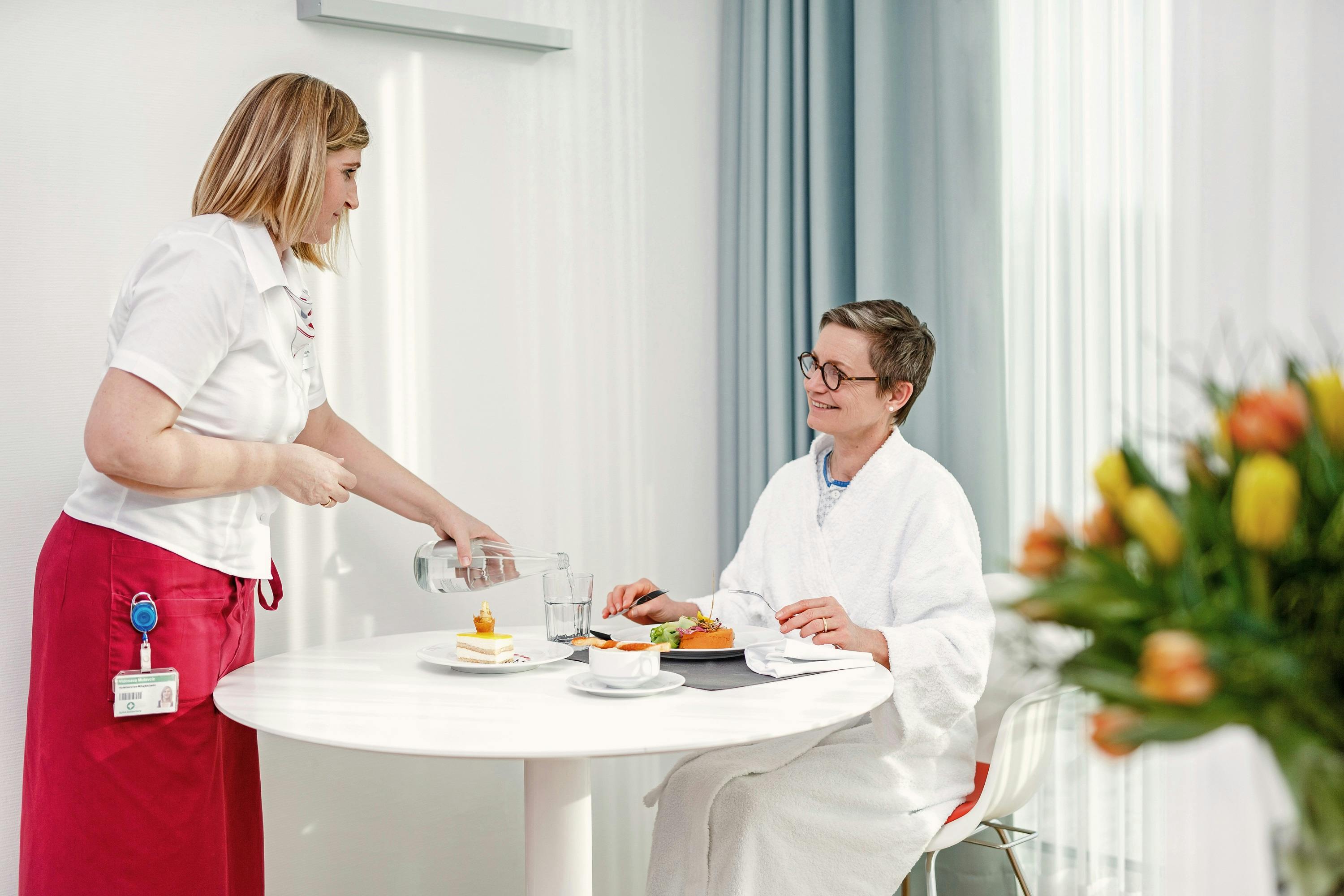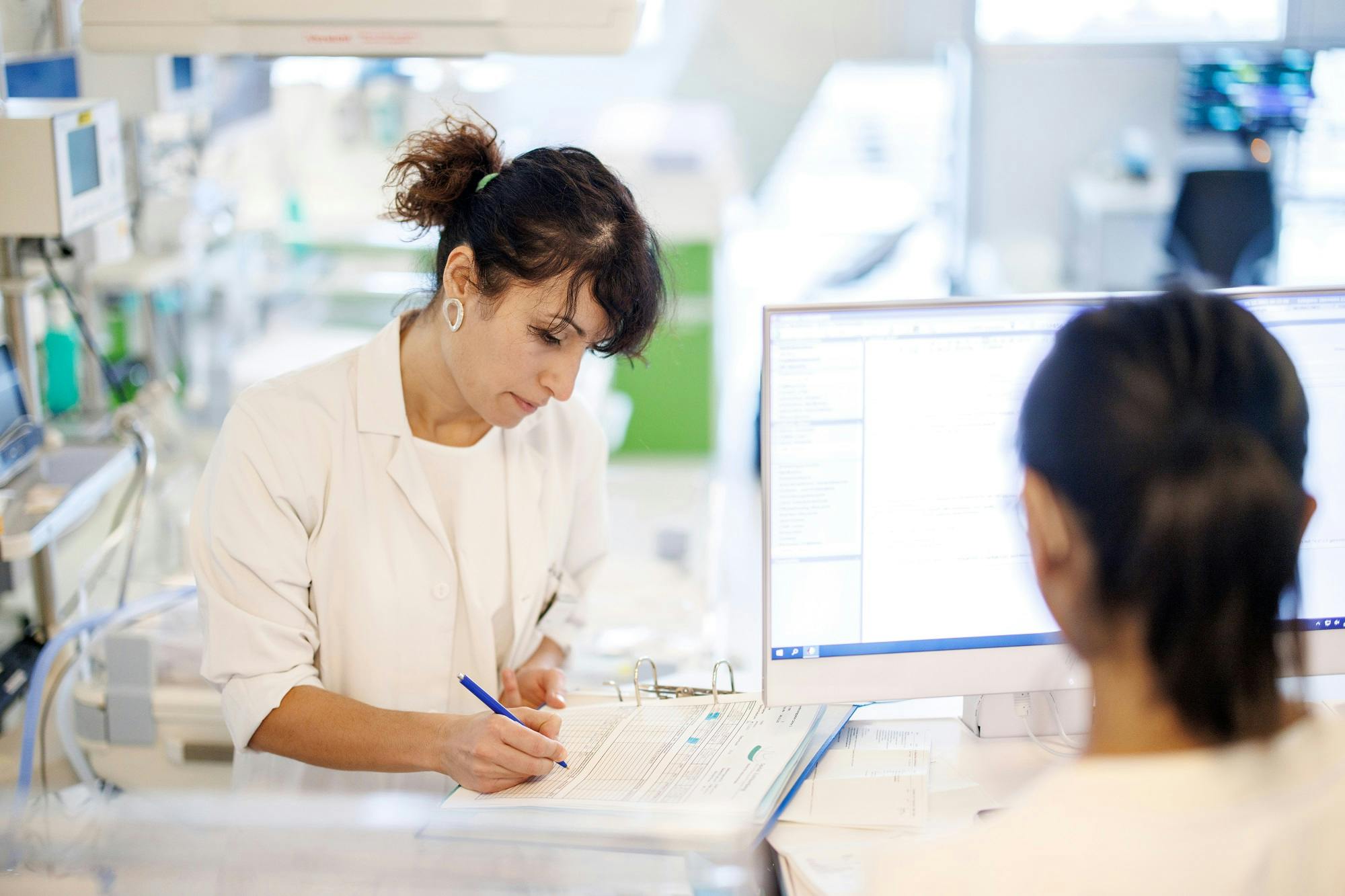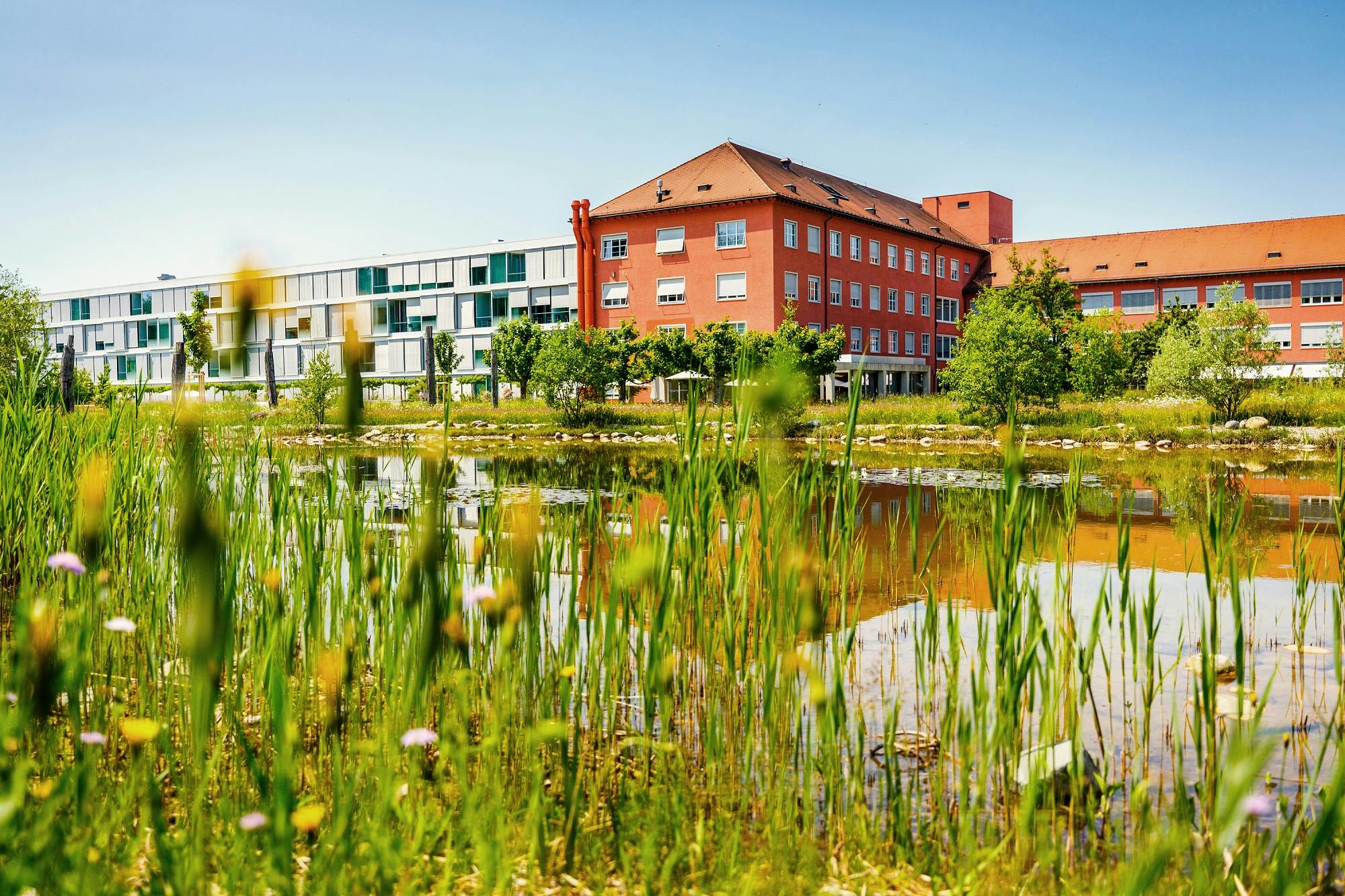Radiology - the photography of the interior
Dr. med. Stephan A. Meier
August 9, 2023
8 min
All about computed tomography (CT)
0/0
What diagnoses can be made on the basis of a CT scan?
Computed tomography allows a large number of diagnoses to be made in a very short time. The disadvantage is that this method works with X-rays. It is therefore mainly used when time is of the essence. For example, after an accident, if an acute injury is suspected, in the event of an acute deterioration of the patient, for example due to an infection/inflammation, or in the case of a suspected tumour, a CT scan is appropriate.
A CT scan is always useful if the diagnosis needs to be made as quickly as possible so that treatment can be given quickly to prevent further damage.
My wife is suspected of having pneumonia. Why is a CT scan carried out?
As a rule, a normal X-ray of the lungs is sufficient for pneumonia. However, it can sometimes be difficult to see the inflammatory changes in the lungs caused by germs. In such cases, a computerised tomography scan is performed. In particular, atypical bacteria or viruses, which only cause very subtle changes in the tissue but nevertheless cause severe symptoms of the disease, can only be recognised in high-resolution tomograms.
There are also diseases that can simulate pneumonia. In order to prove that it is pneumonia, a CT scan may be required in addition to blood or mucus tests to ensure that patients are treated with the right medication and that no more serious illness is overlooked.
What is the most interesting thing you have ever found out thanks to a CT scan?
I experienced a very interesting case as a young senior consultant. I had a patient who had to be repeatedly hospitalised in another hospital due to severe liver inflammation. This was accompanied by chills. Although it subsided after antibiotics, it kept coming back and also showed signs of septicaemia. At the time, it was assumed to be an inflammation of the bile ducts, as nothing indicative could be found in the imaging. I was working at a university hospital at the time and had a computerised tomography scan. In this examination I also found no typical changes in the area of the liver or the bile ducts.
However, there was a bright "dot" about two millimetres in size in the centre of the liver, which I was unable to classify more precisely. No anatomical structure that I knew of matched it. Through some image post-processing, I found out that although this dot was only two millimetres in diameter, it was about two centimetres long and looked like a line. After the three-dimensional reconstruction on the computer, I realised that it was in the immediate vicinity of the first section of the intestine after the stomach, the so-called duodenum.
I then boldly postulated that this could be a swallowed foreign body - such as a toothpick. My thought was that it could have pierced the intestinal wall and travelled to the liver. A foreign body that doesn't belong there and always leads to inflammation in the liver. It was risky to make this suspected diagnosis, especially as a young senior consultant. After all, my diagnosis would lead to a patient having to undergo a dangerous liver operation. What if I was wrong?
The patient was indeed operated on. It turned out to be a small bone from a chicken wing. We all know it, that small but sharp, pointed bone. Part of it was actually lodged in the liver, where it kept causing inflammation.
Afterwards, the patient confirmed that he likes to chew on bones and occasionally swallows them. Although it was ultimately not the suspected toothpick but a bone, it was a foreign body that would have continued to cause inflammation in the liver if it had not been removed. In this respect, the interpretation of the two-millimetre dot in the CT scan was of decisive importance for the patient's recovery.
0/0
My partner had a bad fall on his bike. Why do I need a CT scan now?
In a case like this, you have to assume that there could be life-threatening injuries inside the body. It must now be clarified quickly whether there is bleeding in the head or abdomen, for example, or whether there are organ injuries or life-threatening bone fractures in the area of the spine. If there is a vertebral body fracture, for example, normal movement can subsequently displace the fracture. This can injure the spinal cord and possibly cause paraplegia. A haemorrhage in the head, lungs or abdomen can lead to major blood loss. These are possible injuries that need to be identified as quickly as possible so that no further damage occurs and surgery can be performed as soon as possible.
All these questions arise after a road traffic accident, because it is impossible to know exactly what has happened to the body without looking inside. Computed tomography can answer these questions directly. This is the only way to ensure that many patients survive serious accidents or do not suffer any major/permanent damage.
All about magnetic resonance imaging (MRI/MRT)
0/0
What diagnoses can be made on the basis of an MRI?
The MRI examination has a very good natural soft tissue contrast. This means that different types of tissue can be differentiated from each other, usually without additional contrast agents. This is why it is mainly used when you want to see changes within tissue. This is the case with joints, for example, when you want to distinguish muscles from tendons, cartilage and bones. It is also very good at differentiating between brain parenchyma, which is made up of different types of tissue. MRI is also frequently used to visualise inflammatory changes or fine fractures. In the case of inflammation or a bone fracture, there is always a little more fluid in this area as the body itself tries to heal. It sends certain substances to this area. This increased fluid can be visualised so that inflammation that remains undetected in other examinations can be detected.
I have claustrophobia. Can I still have an MRI scan?
An MRI scan is usually open at the front and back. You will feel cramped in the examination tube, which is quite normal. If someone suffers from claustrophobia, this can be a nightmare. If the MRI is absolutely necessary, we do everything we can to make the examination possible for this patient.
Sometimes it is enough to close your eyes before you are wheeled in. That way, the confinement is not even noticed. A relative or best friend can of course come into the examination room with you and hold your hand to reassure you. This closeness often conveys a sense of security. If this does not work, we can also calm the patient with medication or put him or her to sleep completely so that the time in the tube is not noticed. It is important that we know this in advance so that we can plan accordingly.
Why am I not allowed to eat before an MRI?
That depends on the examination. Eating or drinking causes changes in the body. Depending on what we want to find out, it is important to prevent food intake from visually affecting the area we want to examine. For example, if we want to visualise the liver with the gallbladder and pancreas, it is important that the gallbladder, which empties with food intake, is clearly visible. If this is not observed, it will collapse and a possible gallbladder stone may not be found. Intestinal motility is also increased after eating. This is quite normal as it has to work. However, this interferes with imaging because the intestinal loops are then blurred or out of focus and any malignant changes cannot be seen.
In addition, there are certain substances in food that increase the heart rate, for example. So when we carry out a heart examination, no coffee or tea should be drunk beforehand, as both drinks contain substances that stimulate the circulation.
0/0
Radiology in general: What fascinates you about radiology?
One of the most important things in medicine is finding out why a person is unwell. I find this detective work that you do in radiology extremely exciting. It presents me with new challenges every day. And to be able to do this detective work, you need a good understanding of the human body, its anatomy and its physiology - in other words, how it works. But also an understanding of how diseases develop and behave, what mechanism they use to attack or change the body. In other words, a broad knowledge is necessary to find out why a person is unwell. This has always fascinated me. I wanted and still want to understand why some things are the way they are, why the human body works and reacts the way it does.
I chose radiology because it is linked to almost all other medical disciplines. This means that you are always in contact with medicine as a whole. On the one hand, as a radiologist you specialise in imaging, but in general you remain an essential part of medicine as a whole.
What do you expect to be the biggest innovation in the next five to ten years?
The interesting thing about radiology is that there is always something new happening in the field, the field is constantly evolving. In the next few years, radiology will certainly benefit from the fact that technologies are developing further. This will make examinations faster overall - both for patients and for doctors. Patients will no longer have to lie in a tube for 45 minutes for an MRI, but probably only half the time.
Doctors will be supported by artificial intelligence: to detect a lung metastasis, for example, hundreds of images have to be viewed until this three-millimetre dot is found. In future, the computer will be able to take over this unchallenging task and point out a spot that doesn't belong there. This will allow the doctor to concentrate on the interpretation.
Another development is that there will be special contrast agents that can mark certain diseases. The advantage of this is that even minor changes in the body can be detected as they can be visualised in the image. And the earlier a pathological change is detected, the better it can be treated.
0/0
Weitere Beiträge
Counsellor
Hormone fluctuations in winter: What's really behind them?
Many women experience changes in their physical and mental well-being in winter. They feel tired more often, less resilient or more emotionally sensitive. Cycle changes or more intense premenstrual symptoms are also noticed more often during this time. In addition to external factors such as the cold, less exercise or a change in lifestyle, hormonal processes can also play a role.
Counsellor
Spinal surgery: everything you need to know
At Zollikerberg Hospital, the highest precision applies to one of the most central and at the same time most demanding areas of the body - the spine. Spinal surgery here means not only modern, minimally invasive technology, but above all sound expertise, experience and careful, holistic care. This is what Dr Filippo Mandelli, Head of the Spinal Surgery Clinic, and his team stand for. They treat conditions such as herniated discs, spinal canal stenosis, spondylolisthesis, spinal deformities and degenerative changes competently and sensitively and accompany patients on their way to greater stability and quality of life. In this interview, you can find out what is particularly important in these complex interventions - and what modern spinal medicine can achieve today.
Counsellor
Eyelid lift (blepharoplasty) for drooping eyelids - a brief overview
The eyes are the mirror of our soul - and yet drooping eyelids, bags under the eyes or sagging skin on the eyelid can leave a tired and older impression. If you would like to regain an alert, fresh look, an eyelid lift (blepharoplasty) at Zurich Plastic Surgery can help. In this blog post, Prof Dr Hisham Fansa, Head of Plastic Surgery Zurich, explains why many people decide to have their drooping eyelids corrected and what is important during this procedure.


